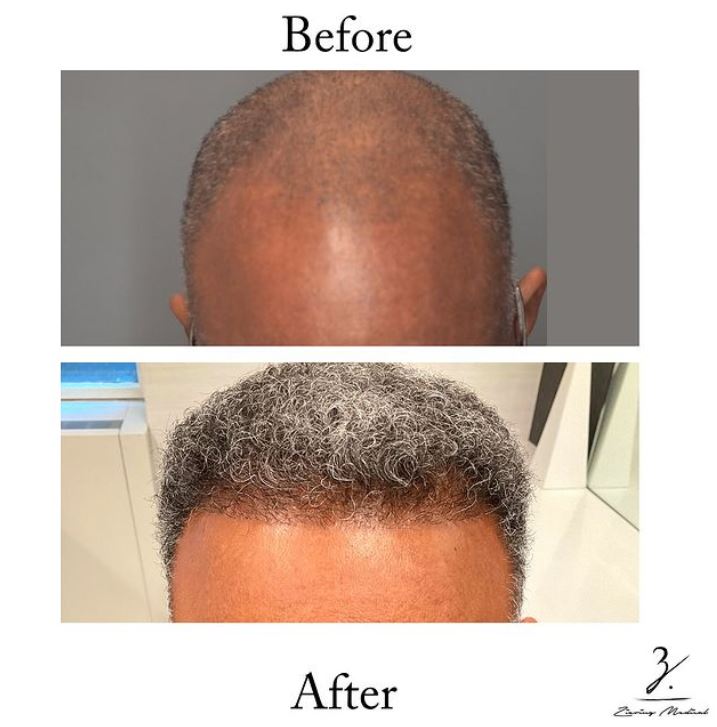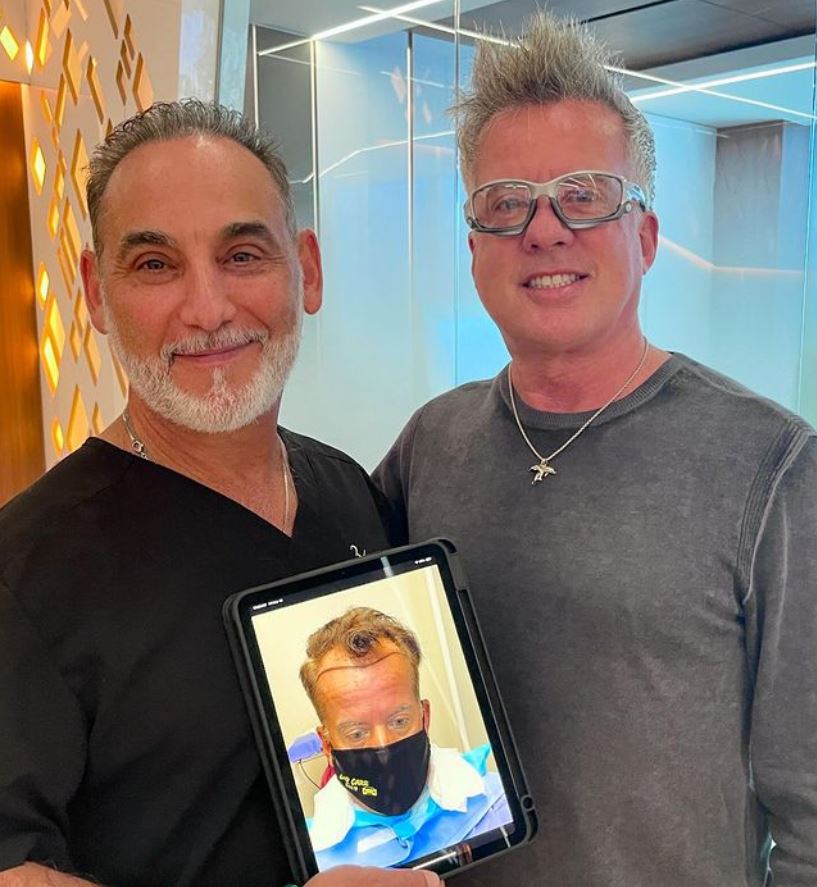Best Hair Restoration Treatments in New York City

Hair loss can be a major setback for a busy professional in New York City. It can make people feel self-conscious about how they look and how others perceive them.
But there are ways to stop hair loss. NYC is home to some of the best hair restoration clinics in the country, with Ziering Medical leading the way.
If thinning hair is becoming a concern, explore Ziering Medical’s advanced hair restoration treatments in NYC.
What is Hair Restoration?
Hair restoration is the process of treating hair loss or thinning. It involves surgical and nonsurgical treatments that help stimulate hair growth, restore hair density or replace hair in areas where it’s thinning.
Surgical options like FUE and FUT move healthy hair from one part of your scalp to another. Non-surgical options such as topical treatments and laser hair therapy help stimulate natural hair growth.
At Ziering Medical, our hair loss doctors offer personalized treatments with natural-looking results that last.
Hair Restoration for Men vs. Women
Hair loss affects both men and women, but it often looks different. Men usually notice hair loss in a more predictable way, like a receding hairline or thinning at the crown.
This is often due to male pattern baldness and it can begin as early as their 20s or 30s and tends to progress over time.
For men, the focus might be on treating areas like a receding hairline or thinning crown, with targeted transplants to boost density where it’s needed most.
On the other hand, female hair loss usually appears as overall thinning across the scalp, particularly along the part line, but rarely leads to complete baldness.
It is often linked to hormonal changes, stress, or genetics and may become more noticeable as they age or after life events like pregnancy or menopause.
Women may benefit more from non-surgical treatments like topicals or low-level laser therapy, which help promote hair growth across the entire scalp.
In some cases, hair transplants can also be a solution, but the treatment must be customized to achieve the most natural look.
If you’re thinking about getting a hair transplant in NYC, it’s important to choose a surgeon who understands the unique differences between male and female hairlines.
Men’s hairlines tend to be more defined, while women’s are softer and more rounded. A skilled surgeon will know how to create a natural look that suits your hair loss pattern and facial features.
At Ziering Medical, our surgeons specialize in creating customized hairlines for all genders including transgender persons, ensuring results that look both natural and aesthetically balanced.
Watch Dr. Craig Ziering Design a Natural Hairline for a Male Patient.
Nonsurgical Hair Restoration Options
Nonsurgical treatments are used to block or counteract the effects of dihydrotestosterone (DHT), the hormone that shrinks healthy hair follicles, causing premature hair loss or thinning.
If you prefer hair restoration treatments that don’t require any downtime, you may be a good candidate for nonsurgical solutions.
They can be used as a stand-alone treatment or in combination with other treatments like hair transplantation.
However, it’s important to know that nonsurgical treatments may not stop hair loss permanently – especially for individuals with pattern baldness. In such cases, we recommend considering hair transplantation.
Oral and Topical Medications
Minoxidil
Minoxidil, found in products like Formula ZMIN, is applied directly to the scalp to help promote hair growth by lengthening the growth phase of your hair follicles and improving hair thickness.
It works well for both men and women experiencing pattern hair loss. Oral minoxidil is also available if you want something more convenient.
Finasteride
Finasteride works by targeting DHT, the hormone responsible for shrinking hair follicles in male pattern baldness. Typically, men are prescribed 1 mg, while postmenopausal women may be recommended 5 mg.
Finasteride helps maintain hair density and encourages regrowth, particularly in men, with noticeable results often appearing within 3-4 months and improving with continued use.
Dutasteride
Dutasteride is also a DHT blocker like Finasteride. However, it’s more potent than Finasteride because it blocks two types of enzymes that produce DHT, specifically Type I and Type II 5-alpha-reductase.
This makes Dutasteride more effective than Finasteride in some cases, which only blocks Type II. Dutasteride may provide better results for those who haven’t experienced enough improvement with finasteride.
If finasteride isn’t slowing or reversing hair loss as expected, switching to Dutasteride might be a better option.
Important Consideration
Both Finasteride and Dutasteride require a prescription and a consultation with one of our hair loss physicians.
Z-Factors
Z-Factors is a next-generation topical treatment for hair loss developed by Dr. Craig Ziering. It’s loaded with powerful hair growth factors, nanoparticles, cytokines, proteins, and peptides.
When applied topically to the scalp, your hair follicles receive a boost of nutrients, giving you healthier, fuller hair.
Unlike PRP treatments for hair loss, Z-Factors eliminate the need for blood draws and injections so you’ll find it as a more convenient option.
Laser Therapy (In-Clinic and At-Home)
Both in-clinic laser therapy and at-home devices, such as the Z CAP, utilize low-level laser therapy (LLLT) to improve blood circulation, reduce inflammation, and enhance cellular activity in the scalp which support hair growth and health.
Many of our patients love this treatment because it’s so convenient with no downtime, making it perfect for patients who are always on the go.
Stem Cell Banking
Imagine being able to save your hair for the future—literally. In partnership with Acorn Biolabs, Ziering Medical offers the world’s first non-invasive way to preserve your hair follicle cells.
By banking your stem cells now, you can safeguard them for potential hair restoration treatments down the line. This is the future of hair restoration.
Surgical Hair Restoration Options
We often recommend nonsurgical treatments as our first line of defense against hair loss and many of our patients are happy with our advanced medical treatments.
However, if your hair loss has reached a point where non-surgical options aren’t giving you the results you want, hair transplantation might be worth considering.
Hair transplantation is a proven solution to restoring a fuller head of hair and when done by the world-class surgeons at Ziering Medical, your results can look remarkably natural.
At our practice, our surgeons perform FUE and MDEE hair restoration using the most advanced techniques and tools in our state-of-the-art facility.
Follicular Unit Extraction (FUE)
FUE is a minimally invasive hair transplant technique that requires shaving the hair short in the donor zone, usually back or sides of the head.
These individual hair follicles (occuring in 1-4 follicular units) are then harvested one at a time directly from the donor area and transplanted into the thinning or balding areas of the scalp. This advanced procedure offers natural-looking results with less downtime.
Microscopic Dissection (MDEE)
MDEE, formerly known as strip FUT, is a refined hair transplantation technique pioneered by Dr. Ziering.
It uses specialized microscopes to dissect grafts from a strip of skin removed from the donor area and transplant hair follicles to the balding and thinning zones.
This cutting-edge approach typically delivers a higher yield of donor hair grafts and offers natural-looking results, even in challenging cases of hair loss.
Because this method doesn’t require the head to be shaved short, it is preferred by women and men who don’t want to shave their hair for surgery or who opt to wear their hair longer.
New York’s #1 Hair Restoration Clinic—Book a Consultation Today.
Led by celebrity surgeon Dr. Craig Ziering, Ziering Medical has some of the best hair transplant doctors in New York City.
Together, they have 75+ years of surgical experience and have performed 50,000+ successful hair restoration surgeries with 100 million+ hair grafts transplanted.
But what sets the Ziering Medical Team apart is their ability to create the most natural-looking hairlines and fuller head of hair with shorter recovery time.
For 20+ years, we have been the #1 choice for hair transplant surgery in New York City, with additional clinics in Beverly Hills, CA, and Greenwich, CT.
When you choose Ziering Medical, you are choosing world-class hair loss evaluation, restoration and patient care. Call us to schedule your consultation today.
We serve patients all over the greater Tri-state area of New York, New Jersey, and Connecticut as well as the greater Southern California area from Los Angeles and Beverly Hills to Newport Beach and San Diego.
I’m considering getting a hair transplant. How long does the procedure take?
Both FUE and strip FUT are outpatient procedures that typically take 4 to 8 hours. The exact time depends on factors like the number of grafts being transplanted and the technique used.
How quickly will I see results from surgical hair restoration?
After the transplant, your hair will shed at first, but new growth usually starts within a few months.
The full results, with thicker, mature hair, typically appear around 12 months post-surgery. Your Ziering surgeon will give you a detailed recovery plan and timeline during your consultation.
Will a hair transplant leave visible scars?
With modern techniques like FUE, scarring is minimal and often not noticeable. MDEE may leave a linear scar, but it’s usually thin and concealed by surrounding hair.
Does surgical hair restoration work for all types of hair loss?
Both FUE and MDEE hair restoration work for various types of hair loss, including pattern baldness, traction alopecia, and hair loss caused by physical trauma.
During your consultation at our clinic, your Ziering surgeon will help determine the best approach for your specific situation and whether you’re a good candidate for surgery.
Real Hair Transplant Results

1,700 graft FUE hair transplant to restore his receding hairline and rebuild his temporal peaks. See more transformations like this in our gallery.

36-month post-op transformation from an FUE hair transplant of 2,281 grafts. See more transformations like this in our gallery.
